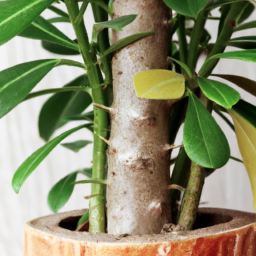
Have you ever wondered if your beloved indoor plants can thrive in the great outdoors? Maybe you’ve been thinking about adding some greenery to your garden but aren’t sure if your indoor plants will adapt to the outdoor environment. Well, you’re in the right place because today we’re going to explore the question, “Will indoor plants grow outside?” It’s a common curiosity among plant enthusiasts, and we’re here to shed some light on the topic. So, grab a cup of tea, sit back, and let’s dive into the world of indoor plants and their potential to flourish in the great outdoors.
Understanding the Growth Potential of Indoor Plants in Outdoor Environments
Indoor plants are a delightful addition to any home or office space. They not only enhance the aesthetic appeal but also provide numerous health benefits. However, have you ever wondered if these plants can thrive when placed outside? In this article, we will explore the growth potential of indoor plants in outdoor environments and provide you with a step-by-step guide to help you make the transition successfully.
Factors to Consider
Before moving your indoor plants outside, it is crucial to understand the factors that can influence their growth potential. Let’s take a closer look at these factors:
1. Light Exposure: Indoor plants are accustomed to lower light levels compared to their outdoor counterparts. When transitioning them outside, it is essential to consider the amount of sunlight they will receive. Some plants may require partial shade, while others thrive in direct sunlight. Research the light requirements of your specific plants to provide them with the optimal conditions.
2. Temperature: Indoor plants are typically exposed to stable temperature conditions. Outdoor environments, on the other hand, can experience significant temperature fluctuations. It is important to choose a suitable time to move your plants outside, ensuring that the temperatures are within their tolerance range. Gradually acclimatize them to the outdoor temperatures by placing them in a shaded area initially before exposing them to direct sunlight.
3. Watering: Indoor plants are often watered on a regular schedule, and their watering needs may differ from outdoor plants. When transitioning your plants outside, adjust their watering schedule accordingly. Keep in mind that outdoor plants may require more frequent watering due to increased exposure to sunlight and wind.
Step-by-Step Guide
Now that we have discussed the factors to consider, let’s dive into a step-by-step guide to successfully transition your indoor plants to an outdoor environment:
Step 1: Assess the Plant’s Suitability: Not all indoor plants are suitable for outdoor environments. Research the specific plant species to determine if they can thrive outside. Some plants may be more sensitive to temperature fluctuations or require specific soil conditions. Choose plants that are known to adapt well to outdoor settings.
Step 2: Gradually Introduce Outdoor Conditions: Sudden exposure to outdoor elements can shock the plants and hinder their growth. Begin by placing your indoor plants in a shaded area outdoors for a few hours each day. Gradually increase the duration and intensity of sunlight exposure over a period of several weeks. This will allow the plants to acclimate to the new environment without experiencing stress.
Step 3: Choose the Right Location: Select an appropriate location for your plants based on their light requirements. Some plants prefer full sun, while others thrive in partial shade. Consider the microclimate of your outdoor space, including factors such as wind, humidity, and nearby structures that may provide shade or shelter. Ensure the soil in the chosen location is well-draining and suitable for your plants.
Step 4: Monitor Watering: Outdoor plants often require more frequent watering due to increased exposure to sunlight and wind. Check the moisture levels of the soil regularly and water your plants accordingly. Avoid overwatering, as it can lead to root rot. Adjust the watering schedule based on the specific needs of each plant.
Step 5: Provide Adequate Protection: While outdoor environments can provide numerous benefits to your indoor plants, they are also exposed to potential risks such as pests, diseases, and extreme weather conditions. Monitor your plants regularly for any signs of pests or diseases and take appropriate measures to protect them. Consider using natural pest control methods to avoid harmful chemicals.
Step 6: Prune and Maintain: Regular pruning is essential to encourage healthy growth and maintain the desired shape of your plants. Remove any dead or damaged foliage and trim overgrown branches. Additionally, provide necessary support, such as stakes or trellises, for plants that require it.
By following these steps, you can successfully transition your indoor plants to an outdoor environment. Remember to be patient and observant, as each plant may respond differently to the change. With proper care and attention, your indoor plants can thrive and beautify your outdoor space.

Will Indoor Plants Grow Outside?
Many indoor plant enthusiasts often wonder if their beloved indoor plants can survive and thrive in an outdoor setting. While it may seem tempting to bring your indoor plants outside to enjoy the fresh air and natural sunlight, there are several factors that need to be considered before making the transfer. In this article, we will explore the key factors that determine whether indoor plants can successfully grow outside.
Factors to Consider Before Transferring Indoor Plants to an Outdoor Setting
1. Light Exposure
One of the most crucial factors to consider before moving your indoor plants outside is the difference in light exposure. Indoor plants are accustomed to lower light levels compared to their outdoor counterparts. When transitioning them to an outdoor setting, gradual acclimation is essential to prevent sunburn or shock.
Start by placing your indoor plants in a shaded outdoor area for a few hours each day, gradually increasing the exposure to direct sunlight over a period of weeks. This will allow the plants to adjust to the higher light levels and avoid stress.
It’s important to note that not all indoor plants can tolerate direct sunlight. Some species, such as ferns or peace lilies, prefer indirect or filtered light. Research the specific light requirements of your indoor plants before exposing them to direct sunlight.
2. Temperature and Climate
Indoor plants are often accustomed to stable temperature and climate conditions, which can differ significantly from the outdoor environment. Before transferring your indoor plants outside, it’s crucial to consider the temperature range and climate of your region.
Check the hardiness zone of your area and compare it with the temperature requirements of your indoor plants. If there is a significant difference, you may need to provide extra protection for your plants during extreme weather conditions, such as frost or heatwaves.
Additionally, consider the humidity levels in your region. Some indoor plants thrive in higher humidity, which may not be naturally present in certain outdoor environments. You may need to provide additional misting or humidity trays to ensure optimal growing conditions for your plants.
3. Soil and Drainage
The type of soil and drainage in an outdoor setting can greatly affect the growth and health of your indoor plants. Indoor plants are typically potted in well-draining potting mixes that provide adequate moisture retention.
Before transferring your plants outside, assess the soil in your garden or outdoor area. If the soil is heavy and poorly draining, it’s essential to improve the drainage by adding organic matter or creating raised beds. This will prevent waterlogging and root rot, which can be detrimental to your plants.
Consider conducting a soil test to determine the pH levels and nutrient content of your outdoor soil. Adjustments may be necessary to ensure optimal growing conditions for your indoor plants.
By taking these factors into consideration and providing the necessary adjustments, you can increase the chances of successfully transferring your indoor plants to an outdoor setting. However, it’s important to remember that not all indoor plants are suitable for outdoor growth.
Some plants may have specific requirements or are simply better suited to the controlled environment indoors. Always research the specific needs of your plants and consult with a local gardening expert if you’re unsure about their suitability for outdoor growth.
With proper planning, care, and attention, you can enjoy the beauty of your indoor plants in an outdoor setting, adding a touch of greenery and natural charm to your garden or patio.

Tips for Successfully Transitioning Indoor Plants to an Outdoor Garden
Are you thinking about moving your beloved indoor plants to an outdoor garden? Transitioning indoor plants to the great outdoors can be an exciting and rewarding experience. However, it is essential to ensure a smooth transition for your plants to thrive in their new environment. In this guide, we will provide you with step-by-step tips to successfully transition your indoor plants to an outdoor garden.
Understanding the Needs of Your Indoor Plants
Before making the move, it is crucial to understand the needs of your indoor plants. Indoor plants are accustomed to a controlled environment with stable temperatures, humidity levels, and lighting conditions. Moving them outdoors exposes them to various environmental factors that can significantly impact their growth and overall health.
Firstly, consider the climate in your region. If you live in an area with extreme temperatures or harsh weather conditions, it might not be suitable to transition your indoor plants outside. Some plants thrive in specific climates, while others may struggle to adapt. Research the specific requirements of your plants to ensure they can tolerate the outdoor conditions.
Secondly, assess the lighting conditions in your outdoor garden. Most indoor plants are adapted to lower light levels compared to direct sunlight. Gradually introduce your plants to increased sunlight exposure to prevent sunburn and leaf damage. Start by placing them in a partially shaded area and gradually move them to a spot with more direct sunlight over a few weeks.
Lastly, consider the humidity levels in your outdoor environment. Indoor plants often thrive in higher humidity levels, so it’s essential to monitor the moisture content in the air. If your outdoor garden has low humidity, you may need to mist your plants regularly or use a humidifier to create a more suitable environment.
Preparing Your Indoor Plants for the Move
Once you have assessed the suitability of your outdoor garden and understood the needs of your indoor plants, it’s time to prepare them for the move. Follow these steps to ensure a smooth transition:
1. Repotting: Check if your plants require repotting before moving them outside. If the current pot is too small or the soil is depleted, consider repotting them into a larger container with fresh, well-draining soil. This will provide them with the necessary nutrients and room for growth.
2. Gradual Acclimation: Sudden changes in temperature and lighting can shock your indoor plants. To ease them into the outdoor environment, start by placing them outside for a few hours each day, gradually increasing the duration over a couple of weeks. This gradual acclimation will help your plants adjust to the new conditions without experiencing stress.
3. Pest Prevention: Before moving your plants outside, inspect them for any signs of pests or diseases. It’s essential to address any issues before exposing your plants to the outdoor environment. Treat any infestations or diseases with appropriate organic pesticides or remedies to ensure your plants remain healthy.
Caring for Your Outdoor Plants
Once your indoor plants have successfully transitioned to their new outdoor home, it’s crucial to continue providing them with proper care and attention:
1. Watering: Monitor the moisture levels in the soil and adjust your watering routine accordingly. Outdoor conditions may require more frequent watering, especially during hot and dry periods. Ensure the soil is well-draining to prevent waterlogged roots.
2. Fertilizing: Outdoor plants may have different nutrient requirements compared to indoor plants. Use a balanced, slow-release fertilizer to provide your plants with essential nutrients. Follow the instructions on the fertilizer packaging and avoid over-fertilizing, as it can harm your plants.
3. Pruning and Maintenance: Regularly inspect your outdoor plants for any signs of pests, diseases, or dead/damaged foliage. Prune as necessary to promote healthy growth and remove any unwanted or overgrown branches. Additionally, keep an eye on weeds and remove them promptly to prevent competition for nutrients.
By following these step-by-step tips, you can successfully transition your indoor plants to an outdoor garden. Remember to be patient and observant, as each plant may respond differently to the new environment. With proper care and attention, your indoor plants will thrive and beautify your outdoor space.
Key Takeaways of this article
Many people wonder if indoor plants can survive and thrive when placed outside. After all, indoor plants are accustomed to controlled environments with regulated temperature, lighting, and humidity levels. However, with proper care and acclimatization, it is possible for indoor plants to adapt to the outdoor environment and continue to grow healthily.
When transitioning indoor plants outside, it is crucial to consider the specific needs of each plant. Start by gradually exposing them to outdoor conditions, beginning with a few hours of sunlight per day and gradually increasing the duration over several weeks. This will prevent shock and sunburn, allowing the plants to adjust to the increased light intensity. Additionally, ensure the outdoor location provides suitable conditions for the plant’s growth, such as the right amount of shade, moisture, and soil type. Regularly monitor the plant’s progress and make adjustments as needed to ensure its well-being.
While it may require some extra effort and attention, bringing indoor plants outside can be a rewarding experience. Not only will it give them a chance to thrive in a more natural environment, but it can also enhance the aesthetics of your outdoor space. So, if you’ve been contemplating moving your indoor plants outdoors, with proper care and patience, you can successfully help them adapt and continue to flourish.
Here are the top questions that we were asked:
Q1: Can indoor plants survive if I move them outside?
A1: While it is possible for indoor plants to survive when moved outside, it largely depends on the specific type of plant and the environmental conditions it will be exposed to. Some indoor plants may thrive outdoors, while others may struggle to adapt. It’s important to research the specific needs of your indoor plant and gradually acclimate it to the outdoor environment to increase its chances of survival.
Q2: What factors should I consider before moving my indoor plants outside?
A2: Before moving your indoor plants outside, there are a few factors to consider. Firstly, assess the climate of your region and determine if it is suitable for the particular plant species. Consider the temperature, humidity, and sunlight levels that the plant requires. Additionally, evaluate the outdoor conditions such as wind exposure and potential pests that may harm the plant. Understanding these factors will help you make an informed decision.
Q3: How should I acclimate my indoor plants to the outdoor environment?
A3: Acclimating indoor plants to the outdoor environment is crucial to their survival. Begin by gradually exposing the plant to outdoor conditions, starting with a few hours of indirect sunlight per day and gradually increasing the duration over a couple of weeks. Monitor the plant closely for any signs of stress or damage. Additionally, protect the plant from strong winds and extreme temperatures during the acclimation process.
Q4: Can all indoor plants be moved outside?
A4: Not all indoor plants can be successfully moved outside. Some plants are better suited for the controlled environment indoors and may struggle to adapt to the outdoor conditions. It’s important to research the specific plant species you have and determine if it is suitable for outdoor growth. If in doubt, consult a local horticulturist or plant expert who can provide guidance based on your specific plant’s needs.
Q5: What are the benefits of moving indoor plants outside?
A5: Moving indoor plants outside can offer several benefits. Outdoor environments typically provide more natural sunlight, which is essential for plant growth. Additionally, plants exposed to outdoor conditions may experience improved air circulation, which can help prevent fungal diseases. Outdoor spaces also offer more room for plants to grow and thrive, allowing them to reach their full potential. Finally, being outdoors can positively impact a plant’s overall well-being, resulting in vibrant foliage and better overall health.

James Wong is a renowned ethnobotanist, plant scientist, and local television presenter. With a passion for demystifying plant science, he is known for translating complex botanical concepts into practical advice for everyday plant enthusiasts. James’s expertise spans from traditional gardening to cutting-edge plant technologies, making his insights accessible and informative.


